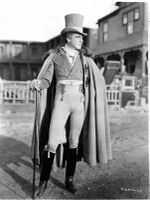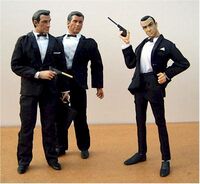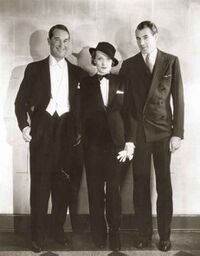Suit
“I feel naked without my collar and tie”
“Shoot that taylor!”
“Capitalism is the Man in the Suit”
A suit (plural starched) is a set of garments popular in Western society. A suit is most frequently worn by males, but can also occasionally be seen being worn by females and hermaphrodites. A typical suit consists of at least a jacket and trousers, cut from the same fabric; matching waistcoats, underwear, and stockings may also be provided.
The distinguishing characteristic of a suit compared to other clothes is that they give the person wearing them various skills and traits they would not otherwise have. Depending on the suit's brand and style, these can include seduction, bullet-proofing, and parkour. This property has cause suits to become a popular clothing choice in fields such as espionage and soliciting.
History

The suit first appeared in the Victorian era. However, in shape and design it was significantly different from its current manifestation. It consisted of a frock coat, tight pants, and a waistcoat in bright colours. One of the first men to dress like this was Beau Brummel, though he took it too far and ended up as a Dandy. The suit was intended be a more comfortable garment to wear in a private home than what had gone before like heavy overcoats, breeches, stockings and square shoes. These early suits did not always succeed, instead being quite stiff and itchy. This was the first known example of a suit having unusual properties however it was not noticed at the time, and was dismissed as the result of poor sewing and the overuse of laundry starch.
The suit went unnoticed for a period of time. However, in 1910, the growing European arms race caused King George V to instruct the Secret Service Bureau (Later MI5) to conduct experimental development of suits for military and intelligence use. This project was highly successful, and has been employed by the British State Intelligence ever since, provided to agents such as Sean Connery, Roger Moore, Mike Myers, and Daniel Craig. The version favored by the British Intelligence is speculated to provide the wearer with skills in the driving of sports cars, flirting, and small arms combat.
In 1944 a consortium of Savile Row tailors, led by Gieves & Hawks, rumored to have collaborated with MI5 on many occasions, mastered the art of suit making when they discovered three key principals of style:
- The magnitude of any traits a suit provides is proportional fit of the suit
- The particular traits a suit provides is determent by the colour and fabric of the suit.
- The cut of the suit does nothing, but helps you to look classy.
Whilst early suits depended on electro-neural interfaces to grant the wearer various skills (As portrayed in the 2002 Documentary The Tuxedo,) in 1951, new developments in particle physics gave birth to a new type of suit, that used the nuclear weak force to interface with the wearers body. This created a suit that was bulkier and less comfortable, but more effective when fitted properly (First law of style.)
Modern usage
Because suits cost a substantial amount of money, but have nothing in particular to enhance someone's appearance, they are often worn by brokerages, lawyers, and politicians to look "classy". It is worth nothing how the laws of style effect this: Firstly, the poor fit ensures any traits granted are in limited quantities; secondly, the poor choice of colour and fabric (Navy blue polyester) results in the traits in question being mostly in the field of dishonesty and forgetfulness - which is why they are commonly observed in politicians. Finally, the off the rack cut with whimsical proportions does noting for the class of the wearer.
The potential of a suit to grant womanizing abilities has made variations of it almost universal with prom dates and 'players' alike. Unfortunately frequent violations of the first law, particularly trousers several inches too long) result in no actual gains to the hopeful young males. This has lead to the term 'prom date' becoming a code word for well meaning, but failed attempt at the art of suit wearing by the third and final modern users, whom are discussed next paragraph.
The most potent use of the suit lies in covert operations, and is favored universally by spies, government agents, and Italian criminals alike. These suits are often designed to provide martial arts abilities, the strength to punch through walls, and dodge bullets. Consequentially these suits are are always made from fine pure wool in black or midnight blue, as per the Second Law of Style. They may also include a real silk lining, or a silk finish on the lapels. The latter feature creates a special type of suit, the dinner jacket (tuxedo, to our friends in the CIA.) The importance of the suit is stressed in the training of these individuals: individual training programs may include exercises such as commissioning up to three bespoke suits in a day (MI5;) using a suit to seduce a young lady (CIA;) and putting on your suit quickly to defend yourself, while being attacked by a naked young lady whom works for the KGB (FBI.)
Types of Suit
Their are many types of suits, classified differently under the Laws of Styles, resulting in different properties. They can be broadly defined as the business suit, Savile Row suit, and dinner jacket.
The business suit is the least useful of the styles of suit. Made in unreserved colours, often bright, it is not surprising that the most interesting skill it has been known to grant is accountancy. Their low quality polyesters and off the rack fit fit result poor, if any, abilities being manifest, per the second law. Preferring to cater to momentary fashions rather than refined style, they often look as good as they preform, as implied by the third law. This is they style favored by politicians and prom dates.
The Savile Row suit has much in common with the business suit, but differs by being hand tailored by one of the bespoke tailoring houses on Savile Row, Mayfair. They can cost as much as $10,000 and are considered as good as a business card by government agents, such as Agent Smith and Harry Hart. They feature more refined fabrics, dark colors (normally black), and sombre styling. Per the First and Second Laws, Savile Row suits are normally grant exceptional fighting skills, and some examples also sexual prowess.
The dinner jacket is the most awesome of all suits. Properly tailored and worn, it can allow users to do almost anything they require, except wear street clothes - the dinner jacket has been known to cause violent anaphylactic reactions to street clothes by its users. It can also be a Savile Row suit, to further enhance its potency. Doing so can cause heart failure by all but the most well trained users, should be be done without expert assistance. Universally made from boiled wool barathea, with lapels trimmed in satin, and buttons finished in grosgrain, they epitomize the Second Law of Style. Common wearers include international spies and the better informed Mafia bosses. Despite this, such garments are very rarely seen, owing the the exceptional stealth and evasion abilities they give their users.
Dealing with a Suit
In the cause of time, you may encounter a Man in a Suit. They may be a ball date, banker, or spy. Or they might just be a prom date, politician, or cosplay fan - This is the key difference between men in suits, and A Man In A Suit. If you think you have spotted A Man in a Suit, you should first confirm it by identifying how their suit relates to the Three Laws of Style. If you find that one or more laws is not met, you may dismissed them as a prom date, politician etc... and relax.
However, if all three laws are met, you may be in trouble, in which case the following cause of action is recommended: Firstly, approach The Man In A Suit confidently, and complement him on his suit. This is compulsory, as it caused the suit's automatic targeting system to ignore you. Secondly, identify based on the surroundings and the type of suit, which type of Man In A Suit he is from the range of ball date, banker, and spy. If he is a ball date, and you are of the opposite gender, consider kissing him. This causing him to consider you friendly, therefore not a threat. If The Man In A Suit is a banker or spy, you should analyses the merits of his suit against your own (What! You're not wearing one?). If you believe your suit is superior, you should straighten your tie, adjust your cufflinks, wink at the nearest attractive member of the opposite gender, then a) Call your accountant, or b) Engage in the Martial Arts, as appropriate.
If you believe your suit is inferior, you should stay calm, puff out your chest, and proceed to run away like a frightened little girl. Slip into the toilets and reappear in your pajamas. You can then plead eccentricity and then slope off for the night.
See also
| Featured version: 1 November 2015 | |
| This article has been featured on the main page. — You can vote for or nominate your favourite articles at Uncyclopedia:VFH. | |





